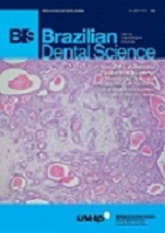Evaluation of 0.5% peracetic acid and 2.5% sodium hypochlorite on smear layer removal of root canal instrumented by three rotary systems
DOI:
https://doi.org/10.14295/bds.2014.v17i1.959Resumo
Objective: The aim of this study was to evaluate the effect of 0.5% peracetic acid solution and 2.5% sodium hypochlorite solution on smear layer removal of root canal walls after rotary instrumentation. Material and methods: Sixty single-rooted human teeth with standardized length had their canals instrumented by three rotary systems (Biorace, MTwo and Endowave), varying the irrigation solution, as follows (n=10): G1- Biorace System + 0.5% peracetic acid solution; G2- Biorace System + 2.5% sodium hypochlorite solution; G3- MTwo System + 0.5% peracetic acid solution; G4- MTwo System + 2.5% sodium hypochlorite solution; G5- Endowave System + 0.5% peracetic acid solution; G6- Endowave System + 2.5% sodium hypochlorite solution. After instrumentation, the roots were cleaved and the dentin walls were evaluated by SEM at x500 and x2000 magnification for assessing the cleaning of the root canals at the cervical, middle and apical thirds. The analyzed area was quantified according to the total number of tubules present and the percentage of open tubules at each region. Data were submitted to statistical analysis by ANOVA and Tukey tests, at the significance level of 5%. Results: There were no statistical significant differences among the experimental groups. In all groups the smear layer removal at cervical and medium thirds was higher than that of apical third. Conclusion: It was concluded that the cleaning obtained at the apical third was lower in all groups studiedand neither the instrumentation technique nor the irrigating solution was able to promote total smear layer removal from root canal walls.
KEYWORDS: Peracetic acid; Root canal irrigants; Scanning electron microscopy; Sodium hypochlorite.
Downloads
Downloads
Publicado
Como Citar
Edição
Seção
Licença
TRANSFERÊNCIA DE DIREITOS AUTORAIS E DECLARAÇÃO DE RESPONSABILIDADE
Toda a propriedade de direitos autorais do artigo "____________________________________________________________________" é transferido do autor(es) para a CIÊNCIA ODONTOLÓGICA BRASILEIRA, no caso do trabalho ser publicado. O artigo não foi publicado em outro lugar e não foi submetido simultaneamente para publicação em outra revista.
Vimos por meio deste, atestar que trabalho é original e não apresenta dados manipulados, fraude ou plágio. Fizemos contribuição científica significativa para o estudo e estamos cientes dos dados apresentados e de acordo com a versão final do artigo. Assumimos total responsabilidade pelos aspectos éticos do estudo.
Este texto deve ser impresso e assinado por todos os autores. A versão digitalizada deverá ser apresentada como arquivo suplementar durante o processo de submissão.




























